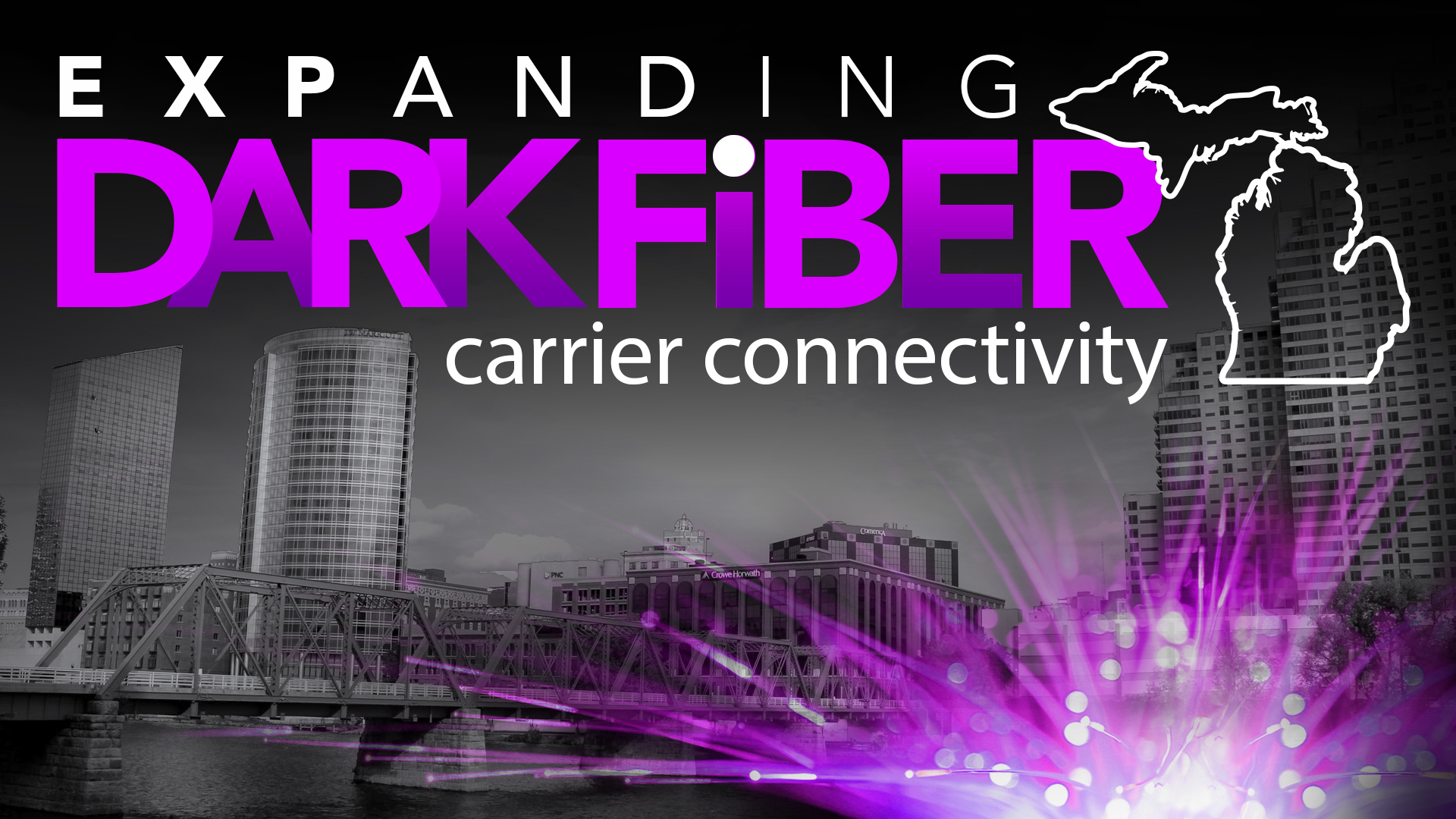
Introduction
Raised floor represents a pivotal innovation in designing and constructing modern infrastructures, particularly within data centers. This architectural feature creates an elevated floor space above the original building surface, providing a hidden void for various utilities. The significance of raised floors extends beyond mere aesthetics; they are crucial for efficiently managing data center construction, offering an organized space for underfloor air distribution, cable management, and critical housing HVAC systems.
The advent of raised flooring systems marks a transformative approach to tackling the perennial challenges of cooling infrastructure, ensuring optimal server performance through effective server rack cooling. With their inherent antistatic properties, these systems safeguard sensitive electronic equipment against potential damage from electrostatic discharges. Moreover, the modular design of raised floors caters to the dynamic nature of technological advancements, allowing for easy reconfiguration and upgrades without significant structural alterations. This guide delves into the comprehensive benefits and applications of raised floors, underscoring their indispensable role in supporting and advancing the operational efficiency of modern-day data centers and commercial buildings. Through energy conservation and enhanced cooling strategies, raised floors epitomize the synergy between architectural innovation and environmental stewardship, setting the stage for the next frontier in infrastructure development.
The Purpose of Raised Floor
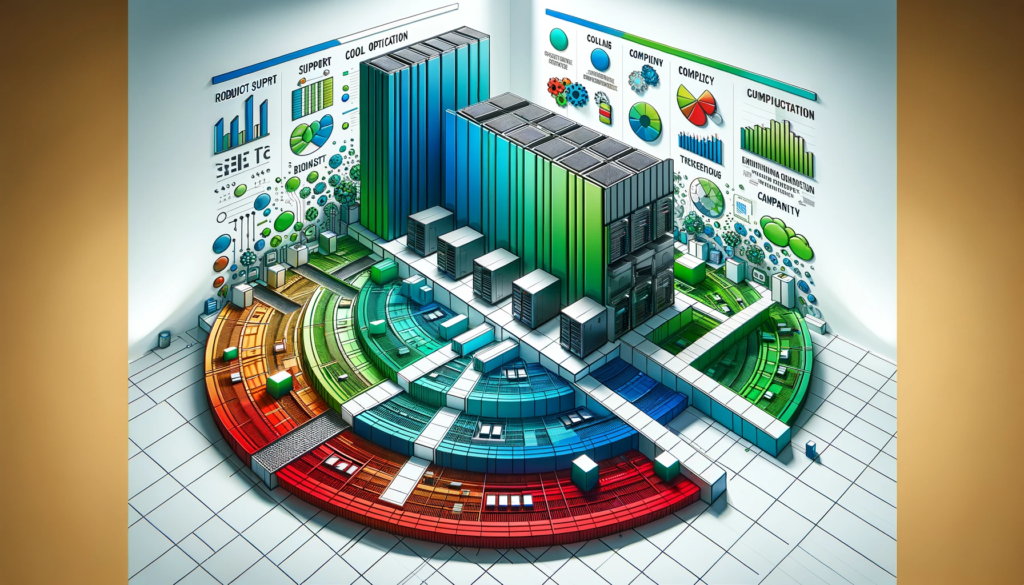
Raised floors serve multifaceted purposes in modern infrastructures, especially within data centers, embodying a critical solution to several operational challenges. Their utility spans various dimensions, from supporting heavy data center equipment to enhancing overall building safety and compliance.
Here’s a detailed exploration of the purposes served by raised floors:
- Supporting Data Center Equipment: Data centers house a significant amount of heavy and sensitive equipment, including servers, routers, and switches. Raised floors provide a sturdy and reliable platform for this equipment, facilitating easy access for maintenance, upgrades, and efficient cable management. This setup optimizes space usage and contributes to the orderly organization of data center components, which is crucial for operational efficiency and safety.
- Enhancing Airflow and Cooling Efficiency: One of the paramount challenges in data center management is maintaining optimal temperatures to prevent equipment overheating. Raised floors address this issue by enabling underfloor air distribution, which allows cool air to be delivered precisely where needed. This system, integral to cooling infrastructure, works in tandem with HVAC systems to ensure a consistent and energy-efficient cooling environment, directly impacting server rack cooling and the overall longevity of the equipment.
- Compliance with Building Codes and Standards: The installation of raised floors assists data centers in adhering to rigorous building codes and standards. These codes encompass requirements for safety, accessibility, and energy efficiency. Raised floors facilitate the implementation of efficient HVAC systems and have inherent antistatic properties, which are essential for meeting the standards set forth for operational safety and energy conservation in technology-heavy environments.
The purpose of raised floors extends beyond mere infrastructure support; it is a strategic investment in the sustainability and efficiency of data centers. Raising floors plays a crucial role in the modern digital infrastructure landscape by providing a versatile platform for equipment support, enhancing cooling efficiency through effective airflow management, and ensuring compliance with building standards. Their adoption signifies a commitment to operational excellence and reflects a forward-thinking approach to architectural design, emphasizing energy conservation and the effective management of technological advancements.
Types of Raised Floors
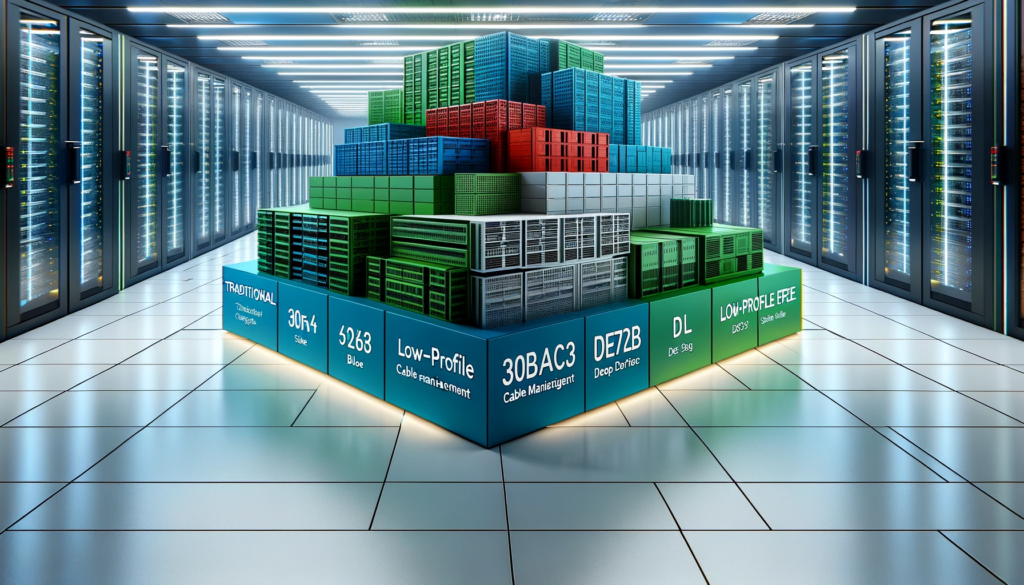
The implementation of raised floor systems in data centers and other critical environments comes in various forms, each designed to meet specific operational requirements and spatial constraints. Understanding the distinctions between traditional and low-profile raised floors is essential for selecting the appropriate system for any application. Here’s a closer look at these two primary types of raised floors:
- Traditional Raised Floors: Traditional raised floor systems are characterized by their significant elevation from the structural floor, typically ranging from 6 inches to several feet. This ample space beneath the raised floor accommodates extensive HVAC systems, complex cable management networks, and even underfloor air distribution systems. The construction of traditional raised floors usually involves sturdy panels supported by adjustable pedestals, providing the flexibility to modify the height as needed to suit the equipment and cooling infrastructure requirements. This type of raised floor is most suited to environments with high demands for airflow management and equipment housing, such as large data centers and telecommunications facilities.
- Low Profile Raised Floors: As a recent innovation, low-profile raised floors offer a solution for spaces that cannot accommodate the height requirements of traditional systems or where only minimal elevation is needed. These systems typically provide a clearance of 2 to 6 inches, enough to manage cabling and provide some underfloor air distribution but without the extensive space reserved in traditional setups. Low-profile floors are engineered for areas where the primary concern is cable management and minor airflow improvement, such as in office spaces, small data centers, and retrofit projects where ceiling height or other constraints limit the use of traditional raised floors.
Construction Differences
- The construction difference between these two types lies in the height and structural design. Traditional systems are built for maximum utility space, supporting extensive infrastructure beneath the floor. In contrast, low-profile systems focus on providing essential services more compactly and less intrusively.
Applications and Suitability
- Traditional Raised Floors are best suited for new constructions or significant renovations where there’s a need for extensive underfloor services, and the building design accommodates such elevation. These are ideal for large-scale data centers, server rooms, and any environment requiring comprehensive airflow and cable management solutions.
- Low Profile Raised Floors find their place in environments where space is at a premium or in buildings with minimal structural modifications. They are suitable for office areas needing efficient cable management, small data centers, and spaces looking to balance infrastructure needs and architectural constraints.
Selecting the correct type of raised floor depends on several factors, including the specific needs for cable management, the required airflow and cooling infrastructure, underfloor services, building codes, and the physical constraints of the space. Understanding these types will help decision-makers choose the most appropriate raised floor system that aligns with their operational objectives and spatial limitations.
Benefits of Raised Floors in Data Centers
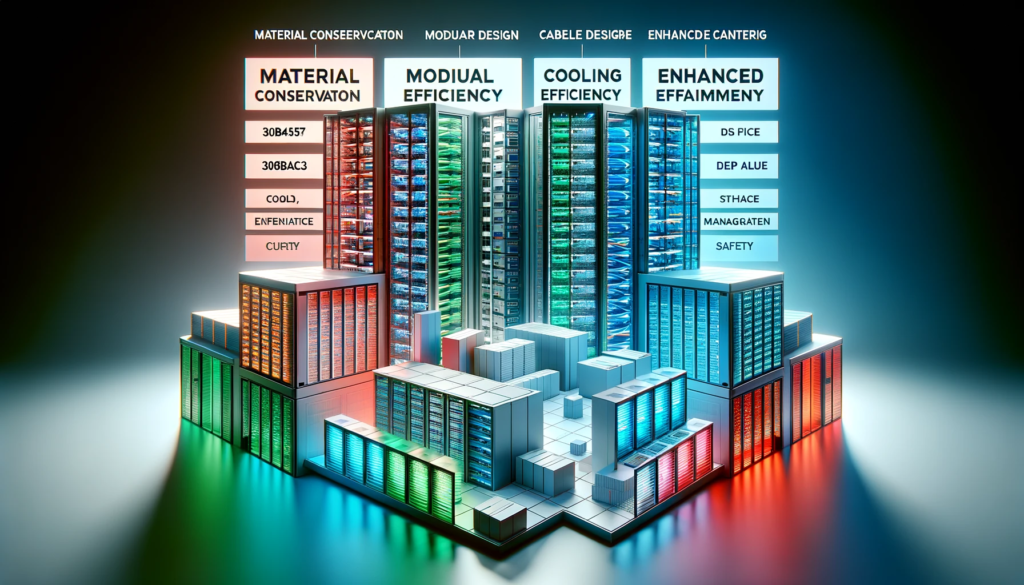
Raised floors in data centers are more than just an architectural feature; they offer many benefits that contribute to these critical environments’ operational efficiency, safety, and scalability. The advantages of implementing raised floor systems are substantial, from material conservation to enhanced cooling strategies.
- Material Conservation and Cost-effectiveness: One of the standout benefits of raised floors is their contribution to material conservation. The modular design of these systems allows for individual tiles or panels to be replaced or updated as needed without the need for comprehensive floor removal. This conserves materials and translates to significant cost savings over time, especially in environments where technological upgrades and changes are frequent.
- Modular Design and Flexibility: The inherent modular nature of raised floors offers unparalleled flexibility in data center design. As the needs of the data center evolve, so too can the layout of the raised floor system. This adaptability is crucial for accommodating new equipment, scaling operations, or reconfiguring spaces to optimize airflow and cooling efficiency. Moreover, the ease with which panels can be removed and replaced facilitates underfloor access for maintenance and installing new services, reducing downtime and operational disruptions.
- Improved Cooling Efficiency and Energy Conservation: Raised floors play a pivotal role in the cooling infrastructure of data centers. By facilitating underfloor air distribution, these systems allow for targeted cooling directly to hot spots, significantly improving the efficiency of server rack cooling. This targeted approach not only ensures the optimal performance of equipment but also contributes to energy conservation. Efficient cooling systems reduce the overall energy consumption of the data center, aligning with sustainability goals and reducing operational costs.
- Material Flexibility and Safety Features: Raised floor systems are available in various materials, each offering specific benefits such as antistatic properties, which are crucial in preventing electrostatic discharge—a common threat to sensitive electronic equipment. The selection of materials can also contribute to the overall safety of the data center, with fire-rated panels and antistatic finishes reducing the risk of fire and equipment damage.
- Enhanced Cable Management: With the space beneath raised floors, data centers can efficiently manage and organize cables and wiring, reducing clutter and enhancing the overall safety and accessibility of the facility. This organized approach to cable management simplifies maintenance and upgrades and improves airflow by eliminating obstacles that could impede circulation.
Best Practices for Raised Floors

Implementing raised floors in data centers involves strategic planning and adherence to best practices to maximize their benefits. From initial design considerations to selecting materials and monitoring for efficiency, these guidelines ensure that raised floor systems contribute positively to the operational effectiveness and sustainability of data center environments.
- Initial Design Considerations: The planning phase is crucial for successfully integrating raised floors. It involves assessing current and future needs, including equipment load, cooling requirements, and space utilization. This foresight ensures the raised floor system can accommodate technological advancements and evolving operational demands. Factors such as the expected load density, the height of the underfloor space for adequate airflow, and the layout for optimal access and efficiency should be thoroughly evaluated.
- Rack Load Densities and Panel Choice: Choosing the right panels and supporting structure is essential to support the varying densities of server racks and other equipment. The floor’s structural integrity must align with the anticipated load to prevent collapse or damage. Manufacturers offer panels with different load-bearing capacities, and selecting the appropriate type based on calculated load densities ensures the safety and longevity of the raised floor system.
- Use of Diffusers and Monitoring for Efficiency: To optimize cooling efficiency, the strategic placement of diffusers under the raised floor can direct cool air precisely where needed, reducing energy consumption and improving server performance. Additionally, implementing a monitoring system to regularly assess airflow, temperature distribution, and the overall performance of the cooling infrastructure helps identify areas for improvement, ensuring the raised floor system operates at peak efficiency.
- Ensuring Proper Airflow Management: Effective airflow management under the raised floor is critical for preventing hot spots and ensuring uniform temperature distribution. This may involve organizing cables and underfloor components to minimize obstruction to airflow and using blanking panels in server racks to prevent air recirculation.
- Anticipating Future Modifications: The modular nature of raised floors means they can be reconfigured as needs change. Planning for future modifications includes ensuring easy access to underfloor areas for maintenance and upgrades and considering the potential for increased cooling demands or additional cabling as the data center grows.
- Maintaining Antistatic Properties: Given the sensitive nature of electronic equipment in data centers, maintaining the antistatic properties of the raised floor is paramount. Regular cleaning with appropriate products and periodic checks of the floor’s conductivity can prevent static buildup, protecting equipment from electrostatic discharge.
Other Applications of Raised Floors
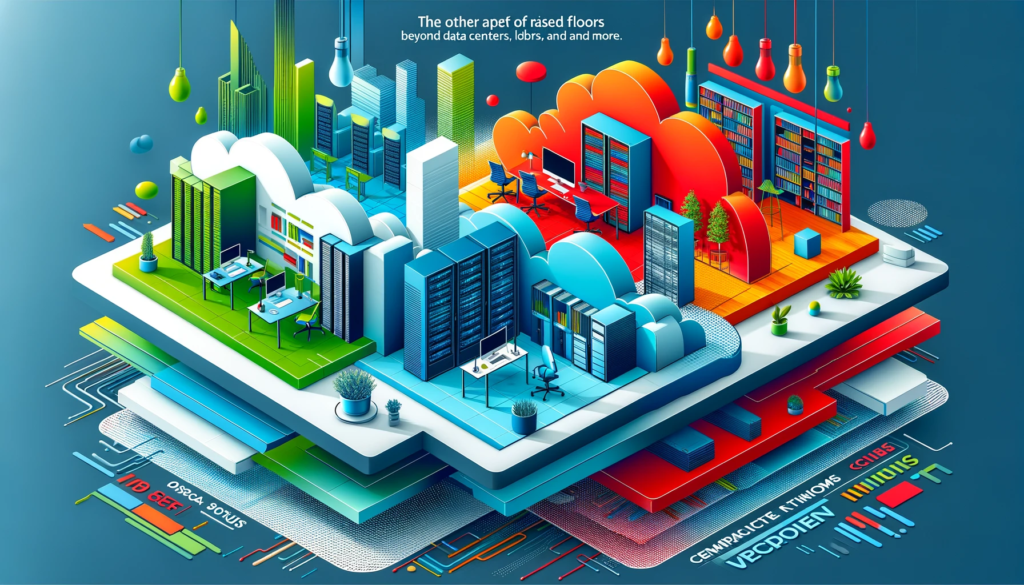
While raised floors are synonymous with data centers due to their significant benefits in cooling infrastructure and cable management, their versatility extends to various environments. These systems provide solutions to common challenges in office spaces, libraries, computer rooms, and beyond, illustrating their broad applicability and utility.
- Office Spaces: In modern office designs, raised floors offer an efficient way to manage power and data cables, creating a clutter-free and adaptable workspace. This flexibility is particularly beneficial in open-plan offices or co-working spaces, where the layout may need reconfiguring to accommodate changing team sizes or functions.
- Libraries and Computer Rooms: Libraries with extensive computer stations and digital archives benefit from raised floors for reasons similar to data centers. They provide a means to cool computer systems and manage cables efficiently, ensuring preserving valuable digital and printed materials in a safe environment.
- Call Centers and Classrooms: Environments that rely heavily on telecommunications equipment and digital learning tools, such as call centers and classrooms, utilize raised floors to simplify cable management and equipment cooling. This infrastructure supports a high density of electronic devices, enhancing operational efficiency and user comfort.
- Command Centers: For facilities that require high levels of security and uninterrupted operation, such as military command centers or emergency response hubs, raised floors offer an effective way to manage cables, power supplies, and cooling systems discreetly and efficiently, ensuring that critical operations can proceed without interruption.
- Broadcast Studios: In the broadcasting industry, raised floors manage the complex web of audio, video, and lighting cables. This setup allows easy access to wires for maintenance or reconfiguration, supporting the dynamic needs of broadcast production.
FAQs Section

What are the main types of raised floors?
Raised floors are primarily categorized into two types: traditional raised floors and low-profile raised floors. Traditional raised floors offer substantial underfloor space for extensive cable management and HVAC infrastructure, making them ideal for data centers and environments with significant cooling and cabling needs. On the other hand, low-profile raised floors provide a minimal elevation that suits offices or spaces requiring less extensive underfloor systems.
How do raised floors improve data center efficiency?
Raised floors enhance data center efficiency in several ways:
- They facilitate underfloor air distribution, improving cooling efficiency and directly contributing to server rack cooling. This targeted cooling approach helps maintain optimal temperatures for equipment operation.
- They allow for organized cable management, reducing clutter and ensuring cables are easily accessible for maintenance or reconfiguration.
- The modular design offers flexibility, enabling data centers to adapt to technological advancements and operational changes without significant disruptions.
Can raised floors be used outside of data centers?
Yes, raised floors are versatile and can be utilized in various settings beyond data centers. They are beneficial in office spaces, libraries, computer rooms, call centers, classrooms, and command centers. In these environments, raised floors provide solutions for cable management, equipment cooling, and space reconfiguration, enhancing operational efficiency and aesthetic appeal.
Are raised floors customizable for specific needs?
Absolutely. Raised floor systems are highly customizable to meet a facility’s particular needs. From the choice of materials with antistatic properties to the height of the elevation for optimal airflow management, these systems can be tailored to the unique requirements of different environments, ensuring that they provide the most benefit in terms of cooling, cable management, and space utilization.
What maintenance is required for raised floors?
Maintenance for raised floors typically includes regular cleaning to prevent dust buildup, periodic inspections of structural integrity, and checks to ensure that antistatic properties are maintained. Additionally, airflow beneath the floor should be monitored to prevent blockages affecting cooling efficiency. Proper maintenance ensures the longevity and performance of the raised floor system.
These FAQs highlight raised floors’ versatility, efficiency, and customizable nature, underscoring their value in various applications, from data centers to educational facilities. Their ability to improve operational efficiency, flexibility, and aesthetics makes them a preferred choice in modern infrastructure design.
Conclusion
Integrating raised floors into the architectural design of data centers and various other environments marks a significant advancement in infrastructure development. These systems are not merely a solution for efficient cable management and cooling infrastructure; they represent a strategic approach to building design that accommodates the rapid pace of technological advancements and the evolving needs of modern operations.
The future of raised floors in infrastructure design is promising, driven by the ongoing demand for data centers and smart building technologies that require sophisticated airflow management, server rack cooling, and modular design for flexibility and scalability. As organizations prioritize energy conservation and operational efficiency, the role of raised floors is set to expand, offering innovative solutions to new challenges.
Adopting raised floor systems is more than an investment in infrastructure; it’s a commitment to creating adaptable, efficient, and sustainable environments. Whether for data centers, office spaces, or command centers, raised floors provide a foundation that supports the dynamic nature of technology-intensive operations. Their benefits—from improved cooling efficiency to enhanced safety and flexibility—underscore the importance of considering raised floors in planning and designing future projects.
As we look ahead, architects, facility managers, and IT professionals are encouraged to consider the long-term benefits of raised floors. Embracing these systems can lead to significant advancements in how we design and operate buildings, ensuring they are capable of meeting today’s demands and prepared for tomorrow’s challenges. Adopting raised floors is a step towards creating more resilient, efficient, and sustainable infrastructures that adapt to the changing landscape of technology and environmental consciousness.




